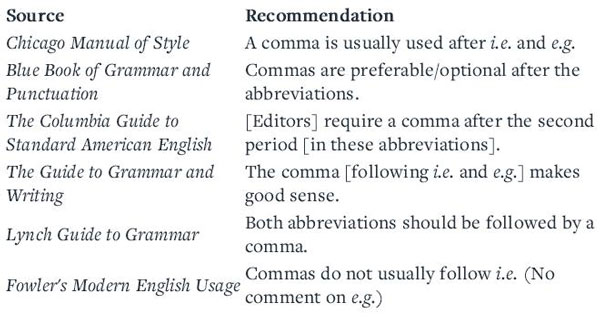當(dāng)前位置: Language Tips> 雙語(yǔ)新聞
What's the Difference Between i.e. & e.g.?
分享到
I.e.和e.g.是書(shū)面英語(yǔ)中常見(jiàn)的拉丁文縮寫(xiě),你知道它們的全拼和含義嗎?事實(shí)上,即使在以英語(yǔ)為母語(yǔ)的國(guó)家,i.e.和e.g.也是人們最經(jīng)常弄混的一對(duì)縮寫(xiě)。

I.e.和e.g.傻傻分不清楚?沒(méi)關(guān)系,下面《紐約時(shí)報(bào)》暢銷(xiāo)書(shū)作家、“語(yǔ)法女王”蜜妮安?福格蒂(Mignon Fogarty)就和同學(xué)們好好聊聊二者的區(qū)別。
I.e.和e.g.啥意思?
I.e. and e.g. are both abbreviations for Latin terms. I.e. stands for id est and means roughly "that is." E.g. stands for exempli gratia, which means “for example.” "Great. Latin," you're probably thinking. "How am I supposed to remember that?”
I.e.和e.g.都是拉丁語(yǔ)縮寫(xiě),i.e.代表id est,意為“也就是說(shuō),即”(that is),e.g.代表exempli gratia,意思是“舉個(gè)例子”(for example)。你可能在想,“很好,拉丁語(yǔ),可我怎么記得住啊?”
如何記住兩者的區(qū)別
Forget about i.e. standing for "that is" or whatever it really means in Latin. From now on, i.e., which starts with i, means “in other words,” and e.g., which starts with e, means “for example.” I = in other words. E= example.
不要去管i.e.的意思或者它的拉丁文全拼。從現(xiàn)在開(kāi)始,i打頭的i.e.代表in other words(也就是說(shuō)),而e打頭的e.g.代表for example(舉例說(shuō)明)。字母I= in other words,字母E= example。
注意事項(xiàng)
Don't italicize i.e. and e.g.; even though they are abbreviations for Latin words, they've been used for so long that they're considered a standard part of the English language.
I.e.和e.g.不用斜體。雖然二者都是拉丁文縮寫(xiě),但這種用法由來(lái)已久,已被視為英語(yǔ)中的一種標(biāo)準(zhǔn)用法。
Also, remember that they are abbreviations, so there is always a period after each letter.
另外,記住i.e.和e.g.都是縮寫(xiě),所以每個(gè)字母后面都有點(diǎn)號(hào)。
A comma is usually used after i.e. and e.g.
I.e.和e.g.后面通常要加逗號(hào)。
福格蒂認(rèn)為,使用i.e.和e.g.時(shí)應(yīng)該在后面加逗號(hào)。她查閱了六本書(shū)寫(xiě)規(guī)范指南,其中有五個(gè)都推薦這種用法。

掌握了這對(duì)縮寫(xiě)的用法后,我們來(lái)做一個(gè)小測(cè)試。看看下面4個(gè)句子,哪些是正確的,哪些是錯(cuò)誤的?
1. The evaluation noted that the employee had frequently exhibited irresponsible behavior (i.e., coming to work late, failing to complete projects).
2. Writing instructors focus on a number of complex skills that require extensive practice (e.g., organization, clear expression, logical thinking, etc.)
3. The general rule is that if a number can be expressed in three words or fewer, it should be written out (e.g., two hundred seventy).
4. Use a comma to enclose (i.e. both before and after) the year in a month-day-year sequence.
以上四句話都不準(zhǔn)確。
第一句中,應(yīng)該用e.g.而不是用i.e.,因?yàn)槔ㄌ?hào)里的內(nèi)容是對(duì)“irresponsible behavior”的舉例。
第二句中,意思是正確的,但是不應(yīng)該在句末使用etc.,因?yàn)閑.g.本身就暗示這只是一部分例子。
第三句中,e.g.不應(yīng)該使用斜體。
第四句中,通常來(lái)說(shuō),i.e.和e.g.后面都需要加逗號(hào)。
以上4句話的正確表達(dá)如下:
1. The evaluation noted that the employee had frequently exhibited irresponsible behavior (e.g., coming to work late, failing to complete projects).
評(píng)估報(bào)告指出,在雇員中存在許多不當(dāng)行為(比如遲到,完不成工作)。
2. Writing instructors focus on a number of complex skills that require extensive practice (e.g., organization, clear expression, logical thinking).
寫(xiě)作教師強(qiáng)調(diào)那些需要大量練習(xí)的復(fù)雜技巧(比如結(jié)構(gòu),清晰的表達(dá)和邏輯性)。
3. The general rule is that if a number can be expressed in three words or fewer, it should be written out (e.g., two hundred seventy).
一般來(lái)說(shuō),如果一個(gè)數(shù)字能夠用三個(gè)或三個(gè)以下單詞表達(dá)出來(lái),那么就應(yīng)該將其拼寫(xiě)出來(lái)(比如two hundred seventy) 。
4. Use a comma to enclose (i.e., both before and after) the year in a month-day-year sequence.
“月-日-年”這樣表達(dá)日期的形式,“年”應(yīng)該用逗號(hào)分隔出來(lái)(即在其前后都使用逗號(hào))。
除了i.e.和e.g.,書(shū)面英語(yǔ)中還有不少的拉丁文縮寫(xiě),我們整理了一些常見(jiàn)縮寫(xiě)的含義及用法,供大家學(xué)習(xí)。
縮寫(xiě):etc.
拉丁文:et cetera /?t?set.?.?/
釋義:等等
例句:She knew all about my schoolwork, my hospital work, etc.
她知道我的學(xué)業(yè)、醫(yī)院工作等所有情況。
縮寫(xiě):ca.
拉丁文:circa /?s??.k?/
釋義:(用于日期中表示大概的數(shù))大約
例句:The antique clock is from ca.1900.
這個(gè)古董鐘表產(chǎn)自1900年左右。
縮寫(xiě):cf.
拉丁文:confer /k?n?f??/
釋義:(提示讀者比較所引用資料中的說(shuō)法與文中的論述)參閱
例句:For the more salient remarks on the matter, cf. "Isis Unveiled," Vol. I.
關(guān)于此事更顯著的評(píng)議可參閱《揭開(kāi)面紗的伊西斯》第一卷。
縮寫(xiě):id.
拉丁文:idem /?i?dem/
釋義:同上,用來(lái)避免(在引用、腳注、書(shū)目等處)重復(fù)某個(gè)男性作者的名字。如果是女性作者,用ead.(eadem)。
縮寫(xiě):ff.
拉丁文:folio /?fo?.li.o?/
釋義:該頁(yè)或該行和接下來(lái)的數(shù)頁(yè)或數(shù)行
例句:……see page 258ff.
參見(jiàn)258頁(yè)以后的內(nèi)容
參考:mentalfloss.com,滬江英語(yǔ)
編譯:董靜
審校:丹妮
上一篇 : 最不給力的求婚方式
下一篇 :
分享到
關(guān)注和訂閱

口語(yǔ)
關(guān)于我們 | 聯(lián)系方式 | 招聘信息
電話:8610-84883645
傳真:8610-84883500
Email: languagetips@chinadaily.com.cn